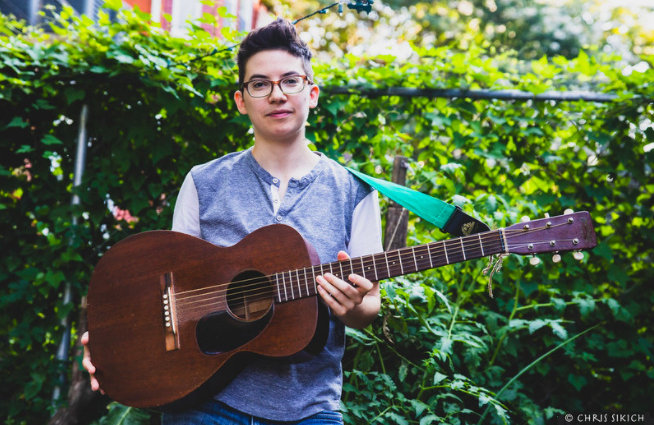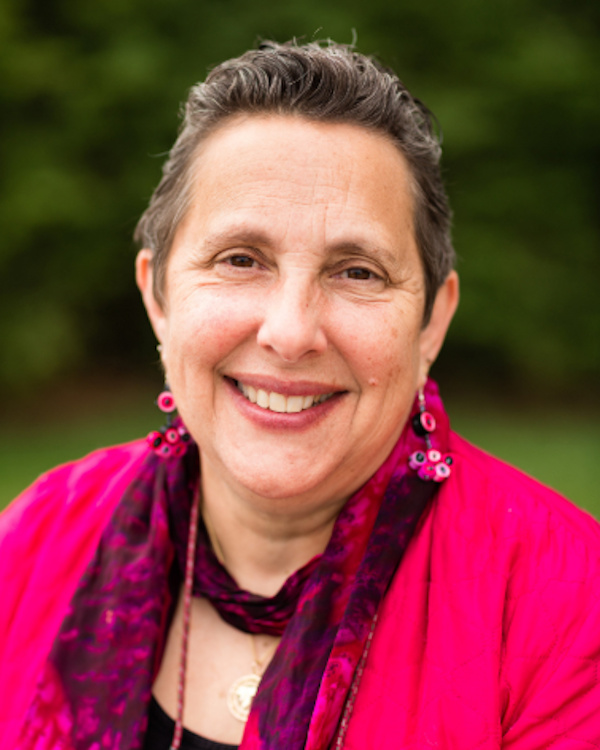In this issue, Pass It On! presents Ants on a Log’s powerful song about confronting racism, “Had to Stand Up.” Also provided is the comprehensive discussion guide, written by Ants on a Log’s Julie Be and CMN member Mara Sapon-Shevin, that shows how to use the song as a starting point for teaching children about bystander intervention. We asked Julie and Mara to share the story of their collaboration on this important guide and how they have applied it to their work with children.
JULIE: For the past twelve summers, I’ve packed up and headed out to New Hampshire, where I served as assistant director at a camp for transgender and nonbinary youth. The camp has been life-changing and life-affirming for me, as well as for the more than 700 campers that we serve each summer. In 2020, as the pandemic prevented our camp community from doing the very thing that we look forward to all year, I decided that if I couldn’t run a camp, I could use other skills to offer connection even in the midst of much distance and isolation.
I spent the summer producing the Trans & Nonbinary Kids Mix, a compilation of songs by artists all across the gender map. The album was created in support of trans kids, and all donations went to camp. One of the songs on the mix was my original “They’re My Best Friend,” which became the first song with nonbinary pronouns to be aired on national radio. The reactions I got from trans families and organizations were huge; while I created the mix to offer connection to trans youth during this tough time, I had not anticipated that educators, community programs, and organizations would also use the music to teach their children and communities. Adults were even using the mix in professional development trainings.
 Julie Be
Julie Be
I began to facilitate virtual family parties with the music of the Trans & Nonbinary Kids Mix. Families gathered on Zoom as I led the group through songwriting, dancing, and collective art-making, all based on songs from the mix. I could see trans kids on the Zoom screen singing along, expressing and seeing themselves in relation to the lyrics. It was a joy to watch the music create this container for their experience.
That summer I had also been attending protests, joining in the communal outrage in the aftermath of George Floyd’s murder. As many white people can relate to, I remember feeling the complicated mix of hopelessness in the face of racism along with the absolute imperative that I must take action, but unsure of how to effect change.
After leaving one protest in downtown Philadelphia, I texted Alastair Moock, a longtime social justice musician and friend who I thought would be particularly familiar with this mix of emotions. He wisely reminded me that “one helps best when they use their largest platform.” Those were words I really needed to hear at that moment, and I agreed with Alastair that, in addition to marching in the streets, I also needed to be speaking from my largest platform: producing music!
As a white person, one of the best ways for me to address racism was to start conversations about race with other white people. With this approach in mind, I wrote “Had to Stand Up,” a story of a white child learning to intervene in the face of racism.
It was important to me to weave body awareness into the lyrics, as it has been shown in study after study how effective it can be to teach kids—and adults—to place thoughts between sensations and actions. In other words, acting on pure feeling is impulsive and even dangerous. Think of a child who feels anger in their chest and reflexively throws a punch. Being able to notice a feeling and translate that into a thought leads to thoughtful action. Now think of the child who feels tightness in their chest, and is able to express, “I feel angry.”
 Mara Sapon-Shevin
Mara Sapon-Shevin
MARA: Julie and I met during a CMN gathering when we started chatting during a session. The discussion was about making classrooms gender inclusive—a phrase we proposed as more reflective of our goals as teachers and activists than the term gender neutral. In getting to know one another, we shared that we were both passionate about confronting racism and homophobia and other oppressive ideologies that kept all people from feeling welcomed, included, and safe.
I am a longtime social justice activist and professor of inclusive education. One of my specialties has been writing curricula for young people and adults about issues of racism, homophobia, microaggressions, and becoming allies/co-conspirators. I have concentrated much of my work on helping young people “stand up” to bullying and prejudice, and as Julie and I learned more about each other’s work, we seemed a perfect match to partner on writing curriculum for their song.
In developing curriculum around taking a stand, I teach that children (and adults) need three things:
- They need to NOTICE that something problematic or discriminatory has happened;
- They need the COURAGE to say or do something; and
- They need specific STRATEGIES for intervening.
The curriculum we developed attends to all three parts of this process. It specifically addresses that our noticing of prejudice or discrimination often gives us a bodily feeling that we should pay attention to. Our curriculum provides opportunities for students to explore what they might say or do in the situation described in the song and to practice saying or doing it.
In my work with children and adults, I have found that most people are eager to explore practical ideas for responding. Many people are so overwhelmed by their feelings—be that anger, guilt, confusion, or worry—that they are unable to formulate a response. And when they don’t act, they are plagued later by guilt and remorse—the I should have said something feeling.
Our discussion guide includes a range of activities for young children and older children as well. By beginning with a song, students have the opportunity to share a common experience that they can reflect upon and then explore. In this way, we are not requiring students to disclose their own struggles with racism and standing up if they are not prepared to do that; it starts with a song that is about other children. This is a useful strategy for opening a discussion that is inclusive and maybe safer.
I have developed curriculum using other songs by CMN members, including “Hey Little Ant” by Phil and Hannah Hoose, “Courage” by Bob Blue, and “When I Get Mad” by Two of a Kind. Using a song as a starting point, not an ending point, for discussion can anchor the exploration in an activity—singing—that engages children and helps them connect to someone else’s story. I have always found that hearing someone else’s story elicits more stories—something like that happened to me—and this means that the learning can be both personalized and expansive.
JULIE & MARA: The “Had to Stand Up” song and discussion guide are available for free at AntsonaLogMusic.com/standup and in this issue of Pass It On! If you use it with children, we would love to hear about your experience. Email AntsonaLogMusic@gmail.com so we can compile successes and challenges and learn from each other’s teaching strategies.